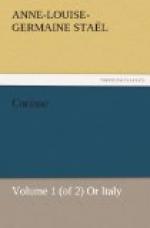FOOTNOTE:
[27] The historical pictures which compose the gallery of Corinne, are either from copies or originals of the Brutus of David, the Maurius of Drouet, and the Belisarius of Gerard; among the other pictures mentioned, that of Dido was done by M. Rehberg, a German painter; that of Clorinda, is in the gallery of Florence; that of Macbeth, is in an English collection of pictures from Shakespeare; and that of Phedre, is by Guerin; lastly, the two landscapes of Cincinnatus and Ossian, are at Rome, and were done by Mr Wallis, an English painter.
Book ix.
THE POPULAR FESTIVAL, AND MUSIC.
Chapter i.
It was the last day of carnival, which is the most noisy festival of the year, when a fever of joy, a mania of amusement, unparalleled in any other country, seized the Roman people. Everybody is disguised; hardly does there remain at the windows, an unmasked spectator: the scene of gaiety commences at a given hour on a certain day, and scarcely ever does any public or private event of the year hinder any person from joining the sports of the season.
It is then that we can form a judgment of the extent of imagination possessed by the common people. The Italian language, even in their mouths, is full of charm. Alfieri said that he went to the public market at Florence to learn to speak good Italian,—Rome has the same advantages: and perhaps these are the only two cities in the world where the people speak so well that the mind may receive entertainment at every corner of the street.
That kind of humour which shines in the authors of harlequinades and opera-buffa, is very commonly found even among men without education. In these days of carnival, when extravagance and caricature are admitted, the most comic scenes take place between the masks.
Often a burlesque gravity is contrasted with the vivacity of the Italians; and one would say that these fantastic vestments inspired a dignity in the wearers, not natural to them; at other times, they manifest such a singular knowledge of mythology in their disguises, that we would be inclined to believe the ancient fables still popular in Rome; and more frequently they ridicule different gradations of society with a pleasantry full of force and originality. The nation appears a thousand times more distinguished in its sports than in its history. The Italian language yields to every shade of gaiety with a facility which only requires a light inflection of the voice and a little difference of termination in order to increase or diminish, ennoble or travesty, the sense of words. It is particularly graceful in the mouth of children[28]. The innocence of this age and the natural malice of the language, form an exquisite contrast. In truth, it may be said, that it is a language which explains itself without any aid and always appears more intellectual than he who speaks it.




